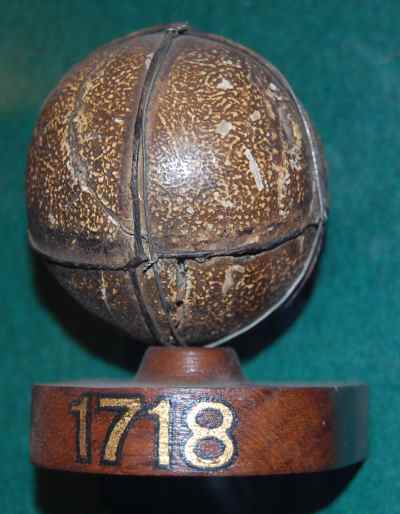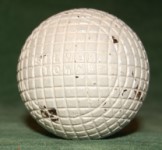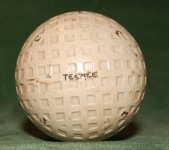Two pieces of equipment are needed to play golf; a club and a ball. The way that golf balls have been made over the last six hundred years has heavily influenced the design of clubs and the manner in which the game has been played.
The first written record of golf in Scotland dates to 1457. It is not known what type of golf balls were in use at that time.
By the early 1600s golf was being played with leather balls stuffed with feathers; these are referred to as "featheries". Only a very small number of original feathery golf balls still exist and they stopped being made in the 1850s. Since 2007 I have devoted a lot of time to making replica feathery golf balls and re-discovering what it was like to play golf with one. If you are seeking to own an original feathery, or a replica ball that I've made by hand, please contact me to discuss the possibilities.

This short article is designed to inform potential buyers of antique golf balls what types of balls exist, the general price ranges and how not to be duped into buying something that isn't genuine, or has little intrinsic value to collectors.
The main types of golf ball:
Feathery Golf Balls (made from about 1600 to 1855).
Every golf ball collector on the planet would love to own a genuine feathery golf ball. However, only several hundred still exist and most of those reside in museum collections. A handful tend to come on to the market each year. Minto condition examples have sold for as much as £30,000. Condition and whether the maker can be identified are the two major factors governing price. A ball in reasonable condition will cost several thousand pounds. If you wish to buy a genuine ball I do occasionally have some for sale. If you have come across an old ball and are wondering if it is a feathery then please send me some inages using my email address info@timewarpgolf.com and I will advise accordingly. It is worth noting that over the last two decades I have received lots of pictures from people making enquiries as to whether the ball they have is a real feathery golf ball; only a very small number have been genuine.
Gutta Percha Golf Balls (1848 to 1898)
Some of the very oldest gutta percha golf balls are rarer than feathery golf balls. They were originally made by rolling lumps of material in the hands and had smooth surfaces. A considerable number of balls labelled as "smooth gutties" have been sold on the open market over the last fifty years or so. In my opinion only a tiny percentage of these balls were genuine smooth balls. If you have any doubt as to authenticity then seek the opinion of somebody you trust and always obtain a written description of the item your buying so that if the ball proves to be something other than genuine you can take legal action to recover the money that you've spent.
That said, there are lots of very nice original gutties dating between about 1870 and 1900 available to buyers. The prices of balls in excellent condition has been rising steadily in recent times. Named models from 1890s, in mint condition, carrying names such as Ocobo and Silvertown are selling for in excess of £600. At the lower end, balls in worn condition are selling for between £100 and £200 each.
Wound Balls Bramble Cover Pattern (1898 to 1925)

How a Haskell model golf ball was first made in 1899 using strips of elastic wound around an inner core.
Wound Mesh Pattern Balls (1910 to 1935)

Round Dimple Balls (1905 to present day)
Gavin Bottrell 07708 661659 (UK mobile) or email info@timewarpgolf.com).Please insert your text here.